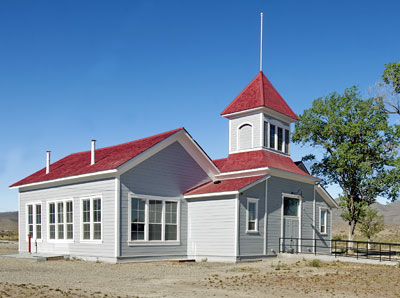National Register of Historic Places in Humboldt County
Golconda School
Morrison Avenue and East 4th Street
Golconda
Built 1888
The Golconda School, built in 1888, is a one-story wood frame structure, designed by architect J.L. Donnel in a vernacular style. The building sits on a one and one-half acre, fenced but otherwise undeveloped site. There are seven historic trees standing north of the structure. Originally built as a school, the building is now [1991] used as a community center. The structure is in excellent condition, and has a very high degree of integrity.
Stylistically, the Golconda School can be seen as a simplified, vernacular variant of the Second Empire style, especially in its projecting entry and bell tower. The belfry is a relic of the time when the school and the church were closely associated in men's minds. It served a useful purpose when reliable watches and clocks were uncommon, and telephones and gongs were unknown.
In the 19th century, the belfry, generally placed above the entrance, was a status symbol for many school districts. In some communities, special subscriptions were taken for a bell tower. Like church bells, these school bells served a variety of functions. Besides calling children to school, the bells were sounded in times of danger, such as mining accidents; and joy, such as at Christmas. Flagpoles often topped the belfry, and the pole atop the Golconda School steeple may have been used for this purpose.
The belfry, while a source of pride in the 19th century, went out of fashion in the 20th and was not used after WWI.
Although the population of Golconda today stands at fewer than 200, Golconda was once a bustling center for mining and agriculture, as well as a popular health resort. Mining commenced in the mineral belt surrounding Golconda in the 1860s. Prior to the completion of the Central Pacific Railroad in 1868, a mill was running about three miles south of Golconda. Ores were being treated here and shipped by ox teams from Golconda to Sacramento.
The development of Golconda as an agricultural center dates from 1862, when the Lay brothers (Louis and Theophile) began to develop the Humboldt Canal. The canal was to irrigate lands below it and run mills on ores from Unionville and other places along the canal route. Although it was never finished, enough was completed to irrigate lands in the vicinity of Golconda. As a result, sheep and cattle businesses steadily developed.
Even before Golconda's mines were discovered, its hot springs were a popular stopping place for travelers. Pioneers on their way to the California gold rush would camp at Golconda long enough to bathe in its waters which were purportedly known for their curative properties from the Missouri to the western slopes of the Sierras. In 1911 the town had four hotels, including one with one hundred rooms.
Source: Adapted from the NRHP Nomination Form submitted in 1991.
